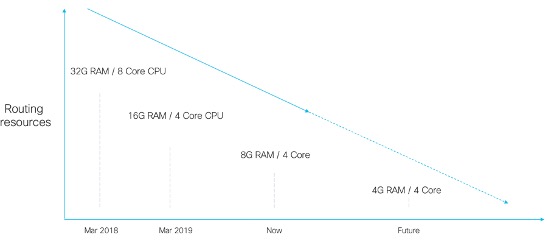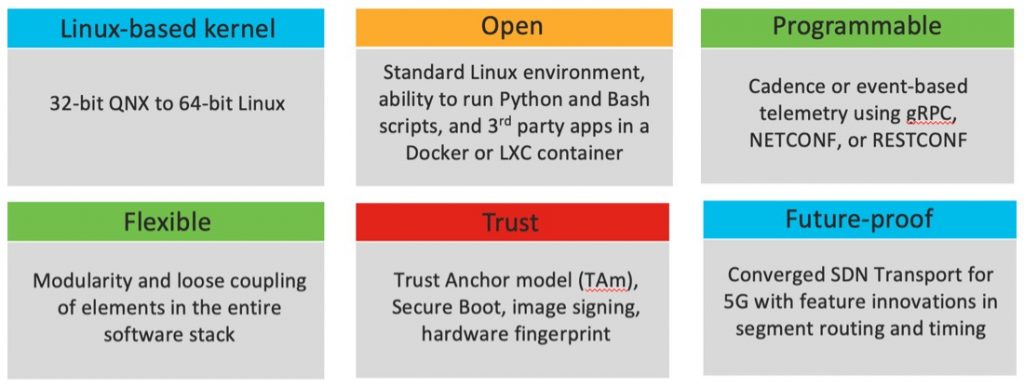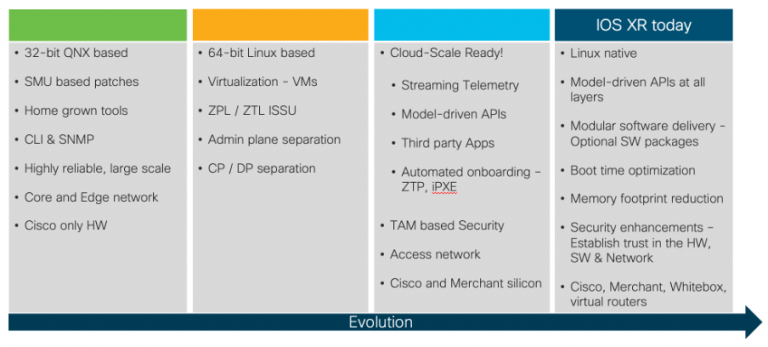Until very recently, the Cisco IOS XR operating system was thought to only apply to huge, fast routers – the likes of Cisco Carrier Routing System (CRS) and ASR 9000. Both are exceptionally successful platforms that have unquestionably shaped the internet. That perception of IOS XR was changed in a massive way with the launch of the IOS XR-based Access Network Portfolio which pushed the trustworthy Network Operating System (NOS) further to the edge of the network with smaller CPU and memory footprints. Now, we’ve pushed the envelope again with the smallest IOS XR router ever – in the Network Convergence System (NCS) 540 Small Density Routers series.
It’s fascinating to think that the same NOS that drives the biggest multi-terabit platforms like the Cisco 8000 Series Routers (260 Tbps) also now drives the smallest (< 100 Gbps). A single, network-wide NOS which scales from 10Mbps to 400Gbps interfaces gives our customers tremendous CapEx and OpEx benefits.
When we built the IOS XR-based Access Network Portfolio there were three major drivers:
1. IOS XR evolution – Open, programmable, simplified, flexible, and secure
2. Hardware engineering innovations – breakthroughs in thermal and energy management
3. NetOps support – the adoption of tools and practices for greater agility and reduced complexity
The evolution of IOS XR has been a journey of obsessing over customer outcomes to build the next generation NOS for the Internet for the Future. For IOS XR-based access routers, the critical challenge was to drive significant footprint reduction that allowed us to build right-sized devices. This meant taking a fresh look at the complete software stack from the foundation on up. Everything was reviewed including state management, process, and data distribution, messaging infrastructure, file systems, packaging, etc. A detailed technical and architectural discussion of the nuances in this journey can be found in this two-part blog.



Innovations in hardware engineering within the IOS XR Access Routing products are key to our capability to support a myriad of deployment scenarios and use cases. Whether an indoor enterprise deployment or a cell site deployment for a Communication Service Provider (CSP), the Cisco IOS XR Access Routing portfolio has right-sized boxes for all needs.
These are the primary hardware design considerations:
• Thermal: Both I-Temp and C-Temp versions of IOS XR access routers
• Energy: Optimizing the watt per bit is a complex balancing act that involves making the mechanical components smarter, such as fans that can change speed with altitude.
• Timing and synchronization: 5G transport networks demand tighter time and phase synchronization and high-accuracy Class C clocks along with GNSS capabilities.
• Corrosion resistance: Conformal coating for deployments in high dust and humidity areas
• Power Supply Unit (PSU) surge immunity
• On-box sensors
• External alarm ports
The NetOps approach to network operations has transformed the way networks are deployed and managed, which is due in large part to the hyperscalers. The overarching theme for NetOps is automation-first simplification and the underlying driver is a massive scale-up in the number of network devices. Rapid adoption of 5G-enabled services combined with analytics, machine learning, and AI will drive exponential growth in access networks.
IOS XR has simplified network operations by supporting:
• Zero-Touch Provisioning (ZTP) for secure device onboarding through template-driven ZTP scripts based on YANG
• Golden ISO (GISO) to bundle necessary packages, custom scripts, and applications into the ISO image
• RPM Package Manager (RPM) format with metadata to resolve package dependencies
• YANG Development Kit (YDK) in Python, Go, and C++
• Easy integration with configuration management tools like Chef, Puppet, and Ansible
• Modern frameworks and specifications like gRPC, gNMI, and Protobuf
The innovation won’t stop here. If you’d like to learn more about our latest routing innovations, check out the NCS 540 series. Also, be on the lookout for future announcements on the Cisco IOS XR-based Access Routing Portfolio as we enable our customers to generate new revenue streams and empower communities to close the digital divide!

Insightful and informative post!
Being ex-Cisco, I am proud of witnessing IOS-XR’s evolution since 2008. ??
Thanks and couldn’t agree more !!
Great Read. Exciting times ahead in the Service Provider space.
Thanks and couldn’t agree more !!